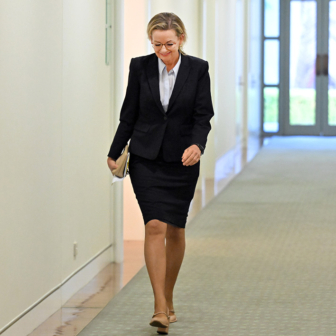At the Coalition’s campaign launch on Sunday, Peter Dutton pulled a rabbit out of his otherwise empty housing policy hat by promising to let first home buyers deduct mortgage interest from their income tax.
In essence, this would extend negative gearing from property investors to new homeowners. Negative gearing allows landlords to offset interest payments on loans against tax liabilities, not just as a deduction from rental returns, but from all sources of income.
Dutton’s pledge flies in the face of countless declarations — from both sides of politics — that the primary cause of Australia’s housing woes is a lack of supply, and the only solution is to build more homes. Rather than increasing supply, mortgage tax-deductibility would boost demand by putting extra money in purchasers’ pockets. Saul Eslake and other economists say this will push house prices even higher, especially when it’s supercharged by the Coalition’s policy of allowing first home buyers to withdraw up to $50,000 from their superannuation.
Some buyers might feel like winners in the short term, but in the long run the scheme would make housing even less affordable than it is now.
The Coalition rejects the criticism by pointing to four ways it would restrict the tax-deductibility scheme.
First, the policy is limited to first home buyers.
Second, buyers can only deduct interest payments on borrowings up to $650,000, and only for the first five years of a loan. The Coalition calculates this would amount to an annual tax break of $11,000 for a household on an average income, or a total saving on mortgage repayments of $55,000.
Third, buyers only qualify for the deduction if their annual taxable income is below $175,000, or $250,000 for a couple. In theory, this “means test” targets the benefits at those households most needing help to get into the market.
But the thresholds are so generous they exclude almost no one. The Grattan Institute calculates that just 5 per cent of taxpayers have a taxable income above $181,000. Nor do the thresholds take account of whether purchasers are also getting a leg-up from rich parents. On top of that, people on higher salaries stand to gain more because they can claim larger deductions. Overall, the policy gives significantly more financial support to relatively well-off home buyers than to those on low and middle incomes.
Finally, and most importantly, the Coalition stresses that it would limit tax deductions to mortgages on newly built homes. Shadow treasurer Angus Taylor says this turns it into a supply-side measure to stimulate residential construction. He told Radio National Breakfast that developers are much more likely to build houses when they feel sure they have buyers.
The Housing Industry Association backs Taylor’s reasoning. In a media release welcoming the Coalition’s pledge, managing-director Jocelyn Martin claimed the Coalition’s policy “could see at least 30,000 new homes commence construction, as first home buyers move out of the established market to build new homes.”
HIA has a dog in this race of course, regardless of the impact of the Coalition’s policy. Its members stand to gain from increased construction, increased real estate prices or any combination of the two.
Still, if the HIA’s logic of limiting tax deductibility to new dwellings holds true for first home buyers, then surely it must hold true for property investors too. In other words, restricting negative gearing to landlords buying brand new homes would also boost supply and help make housing more affordable.
Indeed, this is the argument Labor took to two elections when Bill Shorten was opposition leader. In 2016 and 2019, the party promised to limit negative gearing to new dwellings while grandfathering existing investments. In 2016, shadow treasurer Chris Bowen claimed that the tax break was helping to fund the purchase of new dwellings in only 7 per cent of cases. If the aim of negative gearing is to increase supply, he concluded, “you’ve got a failure rate of 93 per cent.”
Senior Coalition figures have also made this argument about negative gearing over the years. In his 2015 valedictory speech to parliament, former treasurer Joe Hockey declared that “negative gearing should be skewed towards new housing so that there is an incentive to add to the housing stock rather than an incentive to speculate on existing property.” A few months later his successor as treasurer, Scott Morrison, toyed with the idea of reining in negative gearing’s “excesses” but dropped it when Labor made it a campaign policy.
At the 2019 election, the Parliamentary Budget Office estimated that Labor’s negative gearing reforms would increase government revenue by $4.5 billion in their first four years of operation and by more than $22 billion over a decade. Six years later, even larger gains may be on offer. The PBO estimates revenue forgone due to negative gearing at $6.9 billion dollars in 2024–25, while Treasury’s tax expenditure statement reveals that about three-quarters of the gains flow to the top 30 per cent of income earners.
In short, negative gearing costs billions and mostly benefits people who are already very well-off, yet — according to the Coalition’s own logic — fails to do anything to increase the supply of housing.
Given the opposition leader’s concern about Labor racking up “about $1.2 trillion of debt” and senator Jacinta Nampijinpa Price’s DOGE-like task of tackling wasteful spending and making better use of taxpayers’ money, now would be a good time for Dutton to pull another rabbit out of his hat and limit negative gearing to newly built homes.
It would make for more consistent policy, but that’s too much to hope for in an election campaign. •




